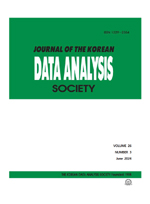분포동학을 통한 중국 위안화 환율의 안정성 및 결정요인 분석
Analysis of the Stability and Determinant of CNY Exchange Rate: The Distribution Dynamics Approach
- 한국자료분석학회
- Journal of The Korean Data Analysis Society (JKDAS)
- Vol.26 No.4
-
2024.081081 - 1094 (14 pages)
-
DOI : 10.37727/jkdas.2024.26.4.1081
- 35

본 연구는 달러화 대비 중국 위안화 환율의 비선형 분포동학(distribution dynamics)을 추정하여 환율의 안정성 및 결정요인을 분석하였다. 구체적으로는 환율의 조건부 확률밀도함수가 이자율이나 화폐공급량과 같은 거시경제변수에 비선형적으로 영향을 받도록 설정하여, 매 시점에서 거시경제변수가 환율분포에 미치는 효과를 추정하여 분석하였다. 본 연구에서 고려하는 환율의 조건부확률밀도함수는 모수의 크기에 따라 단봉(unimodality)과 쌍봉(bimodality)의 형태로 나타날 수 있는데, 단봉형태는 안정적 균형의 상태로 볼 수 있는 반면, 외환위기나 글로벌 금융위기의 시기에는 불안정적 균형이라고 볼 수 있는 쌍봉형태가 나타났다. 또한 본 연구는 실증분석을 통해 환율의 분포동학에 대한 결정요인도 분석하였다. 본 연구는 기존 연구들이 다루지 않은 중국 위안화 환율에 대한 동태적 비선형 모형을 설정하여 분석함에 그 공헌도가 있으며, 분석의 결과에서 나타나는 시사점을 통해 향후 거시경제정책에 도움을 줄 것으로 사료된다.
This study is focused on the stability and determinants of the Chinese Yuan (CNY) against the U.S. dollar exchange rate movement. To this end, a distribution dynamics model is introduced. We establish the non-linearity of the Generalized normal (GEN) distribution and estimate the impact of macroeconomic variables, such as interest rates, on exchange rate dynamic conditional probability density functions (PDFs). As the distribution allows for fluctuations in the exchange rate, the conditional probability density function (PDF) reveals a time-varying multimodality (i.e., unimodality and bimodality), based on the change in the shape parameters of the generalized normal (GEN) distribution. A unimodal distribution corresponds to a stable equilibrium for exchange rate movement. In contrast, a bimodal distribution contains an unstable equilibrium. Moreover, the bimodality may offer insights into the exchange rate fluctuations resulting from foreign exchange crises or global financial crises. In contrast with previous research on the linearity between macroeconomic variables and exchange rate movements, this study presents novel evidence on the dynamic non-linearity distribution of CNY exchange rate movements and their determinants. Our empirical analysis results will serve as a reference point for macroeconomic policymakers.
1. 서론
2. 선행연구 검토
3. 분석 모형
4. 분석자료
5. 실증분석결과
6. 결론
References
(0)
(0)